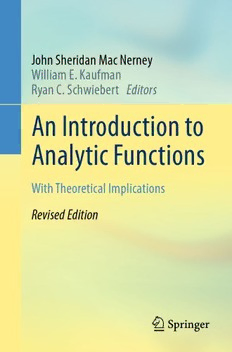
An Introduction to Analytic Functions - With Theoretical Implications PDF
Preview An Introduction to Analytic Functions - With Theoretical Implications
John Sheridan Mac Nerney William E. Kaufman Ryan C. Schwiebert Editors An Introduction to Analytic Functions With Theoretical Implications Revised Edition An Introduction to Analytic Functions John Sheridan Mac Nerney Author William E. Kaufman Ryan C. Schwiebert Editors An Introduction to Analytic Functions With Theoretical Implications Revised Edition JohnSheridanMacNerney Mathematics (deceased) Houston,TX,USA Editors WilliamE.Kaufman RyanC.Schwiebert Mathematics SeegridCorporation (deceased) Coraopolis,PA,USA Athens,OH,USA Previous ‘printings’ by University of North Carolina, Chapel Hill 1959 and University of Houston 1968.Copyrightpresumablyremainedwiththeauthor,nowdeceased.EstatepassedtotheUniversityof HoustonandTrinityCollege. ISBN978-3-030-42084-0 ISBN978-3-030-42085-7 (eBook) https://doi.org/10.1007/978-3-030-42085-7 MathematicsSubjectClassification(2020):30-01 ©UniversityofHoustonandTrinityCollege2020 Thisworkissubjecttocopyright.AllrightsarereservedbythePublisher,whetherthewholeorpartof thematerialisconcerned,specificallytherightsoftranslation,reprinting,reuseofillustrations,recitation, broadcasting,reproductiononmicrofilmsorinanyotherphysicalway,andtransmissionorinformation storageandretrieval,electronicadaptation,computersoftware,orbysimilarordissimilarmethodology nowknownorhereafterdeveloped. Theuseofgeneraldescriptivenames,registerednames,trademarks,servicemarks,etc.inthispublication doesnotimply,evenintheabsenceofaspecificstatement,thatsuchnamesareexemptfromtherelevant protectivelawsandregulationsandthereforefreeforgeneraluse. Thepublisher,theauthorsandtheeditorsaresafetoassumethattheadviceandinformationinthisbook arebelievedtobetrueandaccurateatthedateofpublication.Neitherthepublishernortheauthorsor theeditorsgiveawarranty,expressedorimplied,withrespecttothematerialcontainedhereinorforany errorsoromissionsthatmayhavebeenmade.Thepublisherremainsneutralwithregardtojurisdictional claimsinpublishedmapsandinstitutionalaffiliations. ThisSpringerimprintispublishedbytheregisteredcompanySpringerNatureSwitzerlandAG Theregisteredcompanyaddressis:Gewerbestrasse11,6330Cham,Switzerland Tostudentsofmathematics —J.S.M. ToVirginiaAnnandMac —W.E.K. Formyfriendandteacher,GeneKaufman —R.C.S. Preface by the Editors Mac Nerney’s Introduction to Analytic Functions reflects his craftsmanlike choice of presentation, designed to enable the student the opportunity to engage in mathematical problem solving at the highest level. However, modern conventions andnotationhaveevolvedanddriftedconsiderablyfromthestandardsMacNerney used, and this may act as a barrier for students and instructors considering the originaltextasanoption. Accordingly,thisrevisionseekstopreserveMacNerney’sintentwhileadapting terminology and notation to conform with modern usage, which has now become remarkably consistent throughout the mathematical community. Mac Nerney’s approachisunique,andwehopeyoufindtherevisiontobearefreshingandreadable approachtoanalyticfunctiontheory. Athens,OH,USA WilliamE.Kaufman Coraopolis,PA,USA RyanC.Schwiebert December2019 vii Preface by the Author Thetenchaptersofthisguidebookarethebasisofatwo-semestercoursewhichmy successive beginning classes in function-theory have helped me to develop at the UniversityofNorthCarolinaandtheUniversityofHouston.Therearetwofeatures ofthisdevelopmentwhichIregardasessentialinmathematicaltraining: 1. The concise approach wherein attention is focused on correct mathematical procedures as tools with which one builds upon a few simple facts about numbers,and 2. The pedagogical device whereby the traditional student-teacher relationship is gradually replaced by that of investigators concurrently exploring a logical patternofideas. Exercises, lemmas, and theorems (together with proofs thereof) are intended for classroom presentation and discussion. Insofar as student activity permits, the instructorexpectstoplaytheroleofmoderator—ratherthanthatoflecturer. The reader is cautioned to be critical, and is expected to detect and correct for himself various misprints and misstatements of fact some initially inadvertent and somedeliberateonmypart.Occasionally,Ihaveraisedthequestionwithaclassas towhetherornotsomeofthesemisstatementsshouldbeeliminatedforsubsequent classes:invariably,Ihavebeenansweredinthenegative. In view of the foregoing comments on pedagogy, one should not expect to find in these notes any proof of any theorem. Likewise, I have chosen neither to include any bibliographical references, nor to label theorems with the names of mathematicianscommonlyassociatedtherewith.Fromtimetotime,aftertheorems havebeenprovedinclass,theinstructormaysupplysuchinformation.Ithasbeen my frequent experience, however, that an impressive label on a theorem is likely to have the psychological effect of preventing a student from obtaining a simple contextualproofwhichisavailabletohim. ix x PrefacebytheAuthor I wish to thank my students, and my former colleagues, especially F. Burton JonesandW.M.Whyburn,andmyteacher,H.S.Wall,fortheirencouragementto meduringthedevelopmentofthiscourse. TheUniversityofNorthCarolina JohnSheridanMacNerney ChapelHill,NC,USA June1959 UniversityofHouston Houston,TX,USA August1968 About This Book What TypeofText IsThis,and FromWhence DidItCome? J.S.MacNerneywasastudentofH.S.Wall,theauthorofCreativeMathematics Wall.1 Their teaching styles included elements derived from the Moore Method.2 They both taught by posing problems ranging in difficulty from those one would expect in the usual lectures and texts to others which many might presume to be too difficult for students to solve for themselves. This textbook was produced to facilitateacourseincludingproblemsateverylevel,includingmanythatarequite challenging. We believe it can also be used by some independent learners, and in tutorialsettings. In this book, the method is not geared toward teaching the direct application of the results (in say, a field like engineering), but rather seeks to foster the developmentofmathematicalthinking.Totheextentthatastudenthassuccesswith thismodeoflearning,heorshecouldgoontofurtherchallengesinmathematics, andquitepossiblycreateoriginalmathematics. AprominentfeatureofMacNerney’sstyleisastrongdo-it-yourselfworkethic. AsMacNerneysaysinhispreface,“oneshouldnotexpecttofindinthesenotesany proof of any theorem.” They are purposefully omitted to encourage the student to discoverthemforthemselves.Thissetsitapartfromalmosteveryotherbookonthe topic, and indeed from most expositional mathematics books. In a class like Mac Nerney’s,studentswouldvolunteertopresenttheirproofs,withclassmatesfreeto ask questions and the instructor acting as a moderator. In this way, he cultivated students’abilitytodevelopandrelyontheirownmathematicalskill. 1Wall,H.S.:CreativeMathematics.Classroomresourcematerials.MathematicalAssociationof America,Washington(2009). 2The R.L. Moore Legacy Project: Robert Lee Moore and the Moore Method (2017). http:// legacyrlmoore.org/method.html. xi xii AboutThisBook Mac Nerney and Wall’s implementation of Moore’s style also employed other strategies for isolating student attention. For example, it was made it clear to students that they were not to consult any outside sources such as books or other people—allpresentationanddiscussionwastobeconductedonlyintheclassroom. Insuchacourse,theonlyreadingmaterialthatwasfairgameoutsideofclasswould havebeenasingletextlikethis. SomeoftheinsularitymanifesteditselfinMacNerneyandWall’stextmaterial also. Wall deliberately used “nonstandard” notation and terminology which made it difficult to connect it to more usual notation in other books—e.g. denoting the natural exponential and logarithmic functions by ‘E’ and ‘L’ respectively. Mac NerneyfollowedWall’spracticesfornotationextensivelyintheoriginaleditions. HowIsThisBookDifferentfromPreviousVersions? Why ChangeIt? The main changes in this edition are (1) extensive translation to modern symbols and notation; and (2) revision of the some of the language to lower the cognitive load on the reader. The organization of content was preserved: this virtue of Mac Nerney’stextwillprobablynotshowageforavery,verylongtime. We hope that the benefits of the two changes are fairly self-explanatory. It should improve readability and comprehension, and enhance portability of ideas learned here. That being said, we have striven to retain desirable difficulty at a levelthatispedagogicallyusefulwithoutthebenefitofateacher.Indeed,thebook was originally designed to accompany Mac Nerney’s instruction, but now that his lecturewillnotbeavailablewiththebook,wehavetakenstepstoadaptandmodify exercisestofilloutwhatwasoriginallysuppliedinclass. So, in order to make Mac Nerney’s approach available to new generations of readers and accomplish the goals outlined above, we present this revision of Mac Nerney’sbook. SuggestionsforUsingThisBook Anindependentlearnerwiththemathematicalmaturityofanadvancedundergrad- uateshouldbeabletomanagemostofthematerialofthemainchapters. Inthespiritofthedo-it-yourselfmethod,wewouldliketoencouragethereader toattempttodoasmuchofthebookaspossiblewithoutconsultingothersources. Astudentwiththediligenceandperseverancetodothiswillreaptherewardsofthe exerciselater.
